What is Inflation in Economics?
Inflation in Economics is defined as the persistent increase in the price level of goods & services and decline of purchasing power in an economy over a period of time.
If the rise in prices exceeds the rise in output, the situation is called an inflationary situation.
Inflation can take place due to various reasons. One of the major reasons is a rapid increase in money supply which leads to a decrease in interest rate.
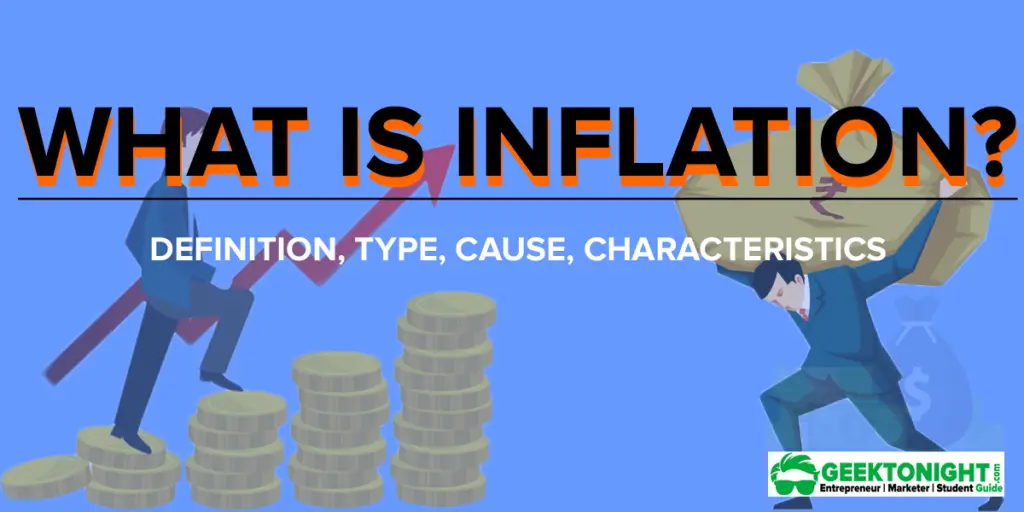
Table of Content
Inflation in Economics Definition
Some of the important inflation in economics definition are:
In the words of Samuleson-Nordhaus, “Inflation is a rise in the general level of prices.”
According to Coulborn, Inflation can be defined as, “too much money chasing too few goods.”
According to Parkin and Bade, “Inflation is an upward movement in the average level of prices. Its opposite is deflation, a downward movement in the average level of prices. The boundary between inflation and deflation is price stability.”
In the words of Peterson, “The word inflation in the broadest possible sense refers to any increase in the general price level which is sustained and non-seasonal in character.”
According to Johnson, “Inflation is an increase in the quantity of money faster than real national output is expanding.”
Also Read: What is Business Economics?
Causes of Inflation in Economics
So what exactly causes inflation in an economy?
Causes of Inflation are:
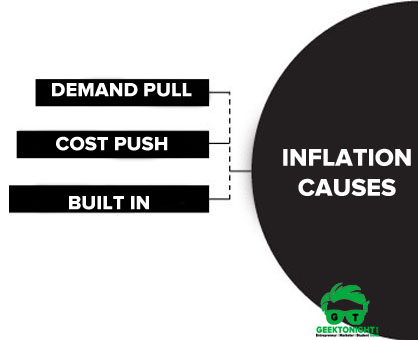
Demand Pull Inflation
- Arises when aggregate demand in an economy outpaces aggregate supply.
- It involves inflation rising as real gross domestic product rises and unemployment falls. This is commonly described as “too much money chasing too few goods”.
- Possible causes of demand-pull inflation:
- Excessive investment expenditures
- Excessive growth of consumption expenditures
- Low-cost loans
- Tax cutting
- Augmentation of government expenditures
Cost Push Inflation
- Cost Push Inflation is a type of inflation caused by large increases in the cost of important goods or services where no suitable alternative is available.
- Possible causes of cost-push inflation:
- Imperfect competition
- Increased taxes
- Rising wages
- Political incidents (like oil crises)
Built In Inflation
- Induced by adaptive expectations, often linked to the “price/wage spiral
- It involves workers trying to keep their wages up with prices and then employers passing higher costs on to consumers as higher prices as part of a “vicious circle.
- Built-in inflation reflects events in the past, and so might be seen as hangover inflation.
Also Read: Micro vs Macro Economics
Characteristics of Inflation in Economics
Inflation is desirable in a country at moderate levels. However, there is no universally acceptable limit of inflation. Depending on the contribution, a country decides the acceptable limit of inflation.
Characteristics of Inflation are:
- Inflation is followed by the price rise.
- The cause behind inflation is increase in the money supply. Thus, it is a monetary phenomenon.
- Due to interaction among various economic forces, inflation is also an economic phenomenon.
- Inflation occurs in a dynamic environment over a period of time.
- Inflation is always scarcity oriented and occurs in a disequilibrium state of economy.
- The rise in prices in inflation cannot be reversed.
- Inflation is persistent in nature. Generally, inflation is categorised on the basis of its rate.
Also Read: Scope of Economics
Types of Inflation in Economics
Let us discuss these three types of inflation in economics in detail.
3 Types of inflation are:
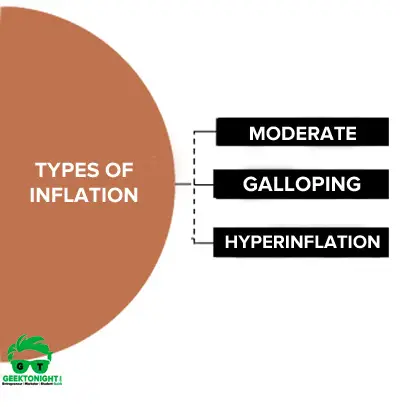
Moderate Inflation
Moderate Inflation is a type of inflation that takes place when there is a rise in the prices of goods and services at a single rate annually. Moderate inflation is also known as creeping inflation.
At the time of moderate inflation in an economy, the prices of goods and services increase only at a moderate rate. However, the rate of increase in prices differs in different countries. It is easy to anticipate moderate inflation; therefore, individuals hold money as a store of value.
Galloping Inflation
Galloping Inflation is a type of inflation that takes place at the time of the rise in the prices of goods and services at a two-digit or three-digit rate per annum. Another name for galloping inflation is as jumping inflation.
In the words of Baumol and Blinder, “Galloping inflation refers to inflation that proceeds at an exceptionally high.”
The worst sufferers of galloping information are middle and lower class individuals. Due to this, people are unable to save money for the future. This kind of situation requires strict measures to control inflation
Hyperinflation
Hyperinflation is a type of inflation that takes place when the rate of increase in prices is extremely high or out of control. In other words, hyperinflation occurs when the increase in prices is more than a three-digit rate annually.
The cause behind hyperinflation is the unrestricted increase in the supply of money in the market. This results in a situation of imbalance in the supply and demand for money. Consequently, money loses its real worth at a rapid speed.
Also Read: Law of Economics
Other Types of Inflations
Inflation may also be classified on the basis of the ‘factors’ which cause this- Phenomenon. Under this head, we shall consider not only currency and credit inflations but also profit-induced, deficit induced, wage-induced and scarcity-induced inflation.
- Currency Inflation
- Credit Inflation
- Profit-induced Inflation
- Deficit-induced Inflation
- Wage-induced Inflation
- Scarcity-induced Inflation
Currency Inflation
This is the classic type of inflation marked by an excess supply of money in relation to the available output of goods and services. Since the excessive supply of money is confronted with a limited supply of goods and services, it inevitably results in an inflationary rise in the price level. This type of inflation generally occurs at a time of war.
Credit Inflation
Sometimes the government encourages an expansion of credit without expanding the supply of money in circulation. This is known as credit inflation.
The main objectives of credit inflation are:
- to lighten the burden of indebtedness of the farmers
- to expand production
- to mobilize financial resources for development plans.
Profit-induced Inflation
Sometimes the production costs start declining, and consequently, the prices also show a declining trend. But the government does not allow the prices to fall by resorting to artificial means. In such a situation, the prices do not go up but at the same time they are not allowed tc fall down. This situation results in an increase in the profit margins of the producers.
Deficit-induced Inflation
Very often, it happens that the government fails to set up its income to meet the increased expenditure consequent upon the outbreak of the war. This results in a deficit in the budget of the government. The government is not able to cover this deficit by resortingto new taxes and public borrowings.
Under these circumstances, the Inflation government is forced to cover the deficit by resorting to the printing press. This is known as deficit-induced inflation. The government of a backward, underdeveloped country may also be forced to resort to deficit financing to finance its developmental plans. This may result in a rising price level.
Since the deficit in the budget is covered by resorting to the printing press, this type of inflation is known as deficit-induced inflation.
Wage-induced Inflation
When the workers organize themselves into powerful trade unions and force the employers to increase their wages, this inevitably pushes up production costs. Consequently, the prices of goods and services rise upward. This may be referred to as wage-induced inflation.
Scarcity-induced Inflation
When the supply of money does not increase but the supply of goods decreases on account of natural calamities, the prices show an upward trend. This may be called scarcity-induced inflation or production inflation.
Effects of Inflation
3 major effects of inflation are:
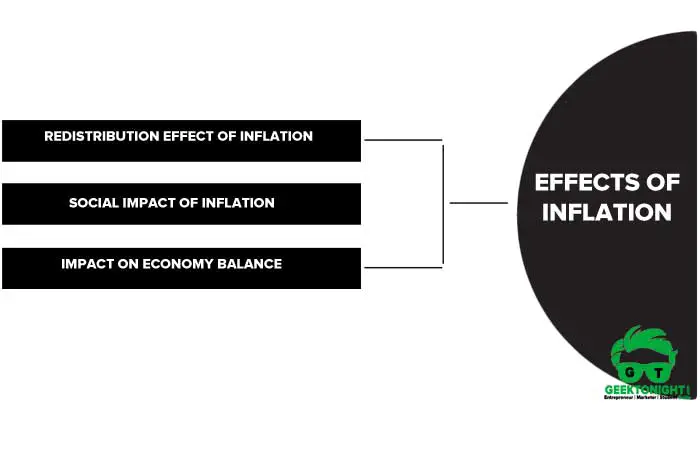
Redistribution effect of inflation
- Inflation affects recipients of fixed income firstly (nominal incomes remain same but the real value of income drop)
- Inflation affects the purchasing power of wages that don’t follow the rise of prices
- Inflation causes diminishing value of loans and savings
- Socially poor persons suffer from inflation more then rich
Impact on economy balance
- Fall of real product bellow potential product
- Changes in the structure of consumption (consumers are buying cheaper goods)
- In case of a fixed currency exchange rate, higher exports are incited
- Inflation deforms prices
- Inflation causes higher costs and makes the economy less efficient
- Creeping and anticipated inflation has a positive effect on the economy and stimulates economic growth
- High inflation and not anticipated inflation are serious problems in the economy.
Also Read: Law of Demand
Stages of Inflation
It is often said that like tuberculosis, inflation passes through three stages. Inflation in the first stage, the rise in prices is slow and gradual. In this stage, it is comparatively easier to check the inflationary rise in the prices of goods and services. But if inflation is not effectively checked in the first stage then like tuberculosis it enters into the second stage.
Inflation, in the second stage, becomes a serious headache for the government. The prices of goods and services now start rising much more rapidly check. In the second stage, it is not possible to eliminate inflation completely, but if the government takes effective steps, it may be possible to prevent a further rise in the price level.
In the third stage, inflation assumes alarming proportions. In this stage, inflation degenerates into hyperinflation or runaway inflation. The prices of goods and services now start rising almost every minute and it becomes impossible for the government to check them. The entire economy of the country is seriously disrupted. Finally, the government is compelled to resort to demonetization of the currency
Now, we shall discuss the above three stages of inflation in more detail:
Pre Full Employment Stage
As said above, the rise in the price level in the fullest stage is less than proportionate to the increase in the supply of money. Let us suppose that the supply of money increases by 10%. As a result, there will be an immediate rise in the price level.
Consequently, the production of goods and services will receive stimulus. As a result of the increase in the output of goods and services, the price level will come down. But if the supply of money is again increased by 10%, the price level will rise up, giving encouragement to the production of goods and services in the economy.
In this way, if there is a continuous increase in the supply of money, a stage will come when the output of goods and services may not increase in the same proportion in which the supply of money increases. The reason being that with the expansion of production, the supply of the factors of production, goes on declining.
The hitherto unutilized resources are now already fully mobilized for production. With the lapse of time, there arises scarcity of productive resources in the economy. Consequently, the rate of increase of production slows down.
Full Employment Stage
If the supply of money continues to increase without any interruption, then after some time production will cease to increase, or in other words, production will become stagnant. The reason being that the productive resources are already fully employed. In other words, there is already full employment of productive resources in the economy.
Extra resources are not available for a further expansion of production. Hence, the further expansion of production comes to an end. Since production becomes constant, the price level now starts increasing in the same proportion in which the supply of money increases.
Post-full Employment Stage
If the supply of money continues to increase even after the point of full employment, then for some time the price level will increase in the same proportion in which the supply of money increases. But after that the supply of money increases so much that the public loses confidence in it and the increase in the price level is much more than the increase in the supply of money.
For example, if the supply of money increases by 10%, then the price level increases by 20%, 30% or even 40%. In such a situation, it becomes difficult, if not impossible, to check the rise in the price level. This is the final stage of inflation. In this stage, the prices rise so high that money exchange comes to be replaced by commodity exchange in due course of time.
Finally, the entire economy collapses with dangerous economic and political consequences for the country.
Business Economics Tutorial
(Click on Topic to Read)
Go On, Share article with Friends
Did we miss something in Business Economics Tutorial? Come on! Tell us what you think about our article on Inflation in Economics | Business Economics in the comments section.
Business Economics Tutorial
(Click on Topic to Read)






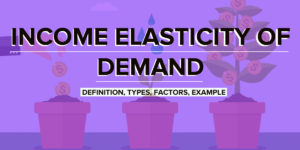




it so helpful i wish you may send me a pdf so that I may keeping on reading